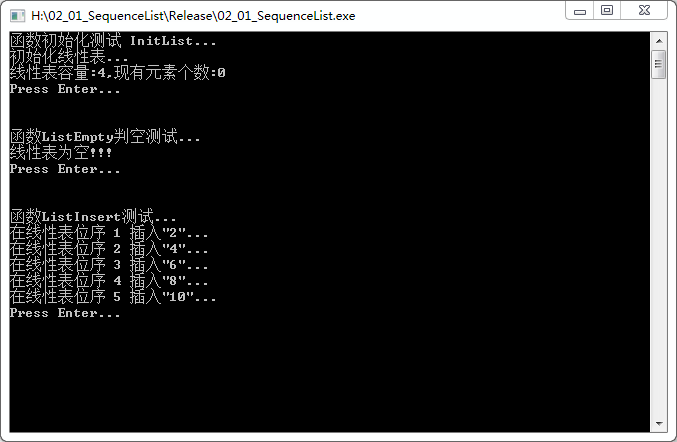代码来源自网络:https://www.cnblogs.com/kangjianwei101/p/5223723.html,归原作者所有。此处做一个记录。
test.c
#include "SequenceList.h" //https://www.cnblogs.com/kangjianwei101/p/5223723.html Status compare(LPElemType elem, LPElemType other); //元素比较函数,other > elem 返回 TRUE 否则FALSE void PrintElem(LPElemType elem); void main(void) { SequenceList list; int i,ERR_CODE; LPElemType elem; printf("函数初始化测试 InitList...\n"); { printf("初始化线性表...\n"); ERR_CODE = InitList(&list); if (ERR_CODE != OK) { printf("初始化失败\n"); } else { printf("线性表容量:%d,现有元素个数:%d\n", list.capacity, list.count); } printf("\n\n"); } PressEnter(); printf("函数ListEmpty判空测试...\n"); { if (ListEmpty(list)) { printf("线性表为空!!!\n"); } else { printf("非空线性表!\n"); } printf("\n\n"); } PressEnter(); printf("函数ListInsert测试...\n"); { for (i = 1; i < 6; i++) { printf("在线性表位序 %d 插入\"%d\"...\n", i, 2 * i); ListInsert(&list, i, 2 * i); } printf("\n\n"); } PressEnter(); printf("函数ListTraverse测试...\n"); { printf("list中的元素为: list = "); ListTraverse(list,PrintElem); printf("\n\n"); } PressEnter(); printf("函数ListLength测试...\n"); { i = ListLength(list); printf("list的长度为 %d\n", i); printf("\n\n"); } PressEnter(); printf("函数ListDelete测试...\n"); { ListDelete(&list,6,&elem); printf("删除 list 中第 6 个元素 \"%d\"\n", elem); printf("list 中的元素为:list = "); ListTraverse(list, PrintElem); printf("\n\n"); } PressEnter(); printf("函数GetElem测试...\n"); { GetElem(list,4 ,&elem); printf("list 中第 4个位置的元素为 \"%d\" \n", elem); printf("\n\n"); } PressEnter(); printf("函数LocateElem测试...\n"); { i = LocateElem(list, 7 , compare); printf("list 中第一个元素值大于\"7\"的元素的位置为 %d\n", i); printf("\n\n"); } PressEnter(); printf("函数PriorElem测试...\n"); { PriorElem(list , 6 , &elem); printf("元素 \"6\"的前驱为\"%d\"\n", elem); printf("\n\n"); } PressEnter(); printf("函数NextElem测试...\n"); { NextElem(list, 6, &elem); printf("元素 \"6\" 的后继为 \"%d\"\n", elem); printf("\n\n"); } PressEnter(); printf("函数ClearList测试...\n"); { printf("清空list之前:"); if(ListEmpty(list)) { printf("list为空!\n"); }else { printf("list不为空!\n"); } ClearList(&list); printf("清空 list 后:"); if(ListEmpty(list)) { printf("list为空!\n"); }else{ printf("list不为空!\n"); } printf("\n\n"); } PressEnter(); printf("函数DestroyList测试...\n"); { printf("销毁list前:\n"); if(list.elem) { printf("list存在!\n"); DestroyList(&list); printf("销毁list后:"); if(list.elem) { printf("list存在\n"); }else { printf("list不存在\n"); } }else { printf("list不存在!\n"); } } PressEnter(); } Status compare(LPElemType elem, LPElemType other) { return other > elem ? TRUE : FALSE; } void PrintElem(LPElemType elem) { printf("%d ", elem); }
SequenceList.h
//Capacity 容器容量 //Count 当前实际个数 #ifndef SEQUENCELIST_H #define SEQUENCELIST_H #include "stdio.h" #include "stdlib.h" //提供malloc,realloc,free,exit原型 zmalloc #include "Status.h" /* 宏定义 */ #define LIST_INIT_SIZE 4 //顺序表存储空间的初始分配量 #define LIST_INCREMENT 2 //顺序表存储空间的分配增量 /* 顺序表类型定义 */ #ifndef LELEMTYPE_SQ #define LELEMTYPE_SQ typedef int LPElemType; #endif typedef struct { LPElemType *elem; //存储空间基址(指针首地址) int count; //当前顺序表长度 count int capacity; //当前分配的存储容量 capacity } SequenceList,tag_List; //初始化空序列表 Status InitList(SequenceList *list); //清空顺序表 void ClearList(SequenceList *list); //销毁顺序表 void DestroyList(SequenceList *list); //判断顺序表是否为空 int ListEmpty(SequenceList list); //返回顺序表的元素个数 int ListLength(SequenceList list); //返回顺序表中第i个元素 Status GetElem(SequenceList list, int i, LPElemType *elem); //返回中首个与e满足Compare关系的元素位序 int LocateElem(SequenceList list, LPElemType elem, Status(Compare)(LPElemType, LPElemType)); //返回cur_elem的前驱 Status PriorElem(SequenceList list, LPElemType cur_elem, LPElemType *pre_elem); //返回cur_elem的后继 Status NextElem(SequenceList list, LPElemType cur_elem, LPElemType *next_elem); //在顺序表的第i个位置插入e Status ListInsert(SequenceList *list, int i, LPElemType elem); //删除顺序表上第i个位置的元素,并用e返回 Status ListDelete(SequenceList *list, int i, LPElemType *elem); //用visit函数访问顺序表 Status ListTraverse(SequenceList list, void(Visit)(LPElemType)); //union //Merge #endif
SequenceList.c
#ifndef SEQUENCELIST_C #define SEQUENCELIST_C #include "SequenceList.h" Status InitList(SequenceList *list) { list->elem = (LPElemType*)malloc(LIST_INIT_SIZE * sizeof(LPElemType)); if (!list->elem) { exit(OVERFLOW); //分配内存失败 } list->count = 0; //初始化顺序表长度为0 list->capacity = LIST_INIT_SIZE; //顺序表初始内存分配量 return OK; //初始化成功 } void ClearList(SequenceList *list) { list->count = 0; } void DestroyList(SequenceList *list) { free(list->elem); list->elem = NULL; list->count = 0; //释放内存后置空指针 list->capacity = 0; } Status ListEmpty(SequenceList list) { return list.count == 0 ? TRUE : FALSE; } int ListLength(SequenceList list) { return list.count; } Status GetElem(SequenceList list, int i, LPElemType *elem) { if (i < 1 || i > list.count/*如果检索的索引超过实际元素的索引长度*/) { return ERROR; //i值不合法 } else { *elem = list.elem[i - 1]; } return OK; } int LocateElem(SequenceList list, LPElemType elem, Status(Compare)(LPElemType, LPElemType)) { int i = 1; //i的初值为第一个元素的位序 while ( i < list.count && !Compare(elem, list.elem[i -1]) ) { ++i; } if (i <= list.count) { return i; } else { return 0; } } Status PriorElem(SequenceList list, LPElemType cur_elem, LPElemType *pre_elem) { int i = 1; if (list.elem[0] != cur_elem) //第一个节点无前驱 { while ( i < list.count && list.elem[i] != cur_elem) { ++i; } if (i < list.count) { *pre_elem = list.elem[i - 1]; return OK; } } return ERROR; } Status NextElem(SequenceList list, LPElemType cur_elem, LPElemType *next_elem) { int i = 0; while (i < list.count && list.elem[i] != cur_elem) { ++i; } if (i < list.count - 1) { *next_elem = list.elem[i + 1]; return OK; } return ERROR; } Status ListInsert(SequenceList *list, int i, LPElemType elem) { LPElemType *newbase; LPElemType *p, *q; if (i < 1 || i > list->count + 1) { return ERROR; } if (list->count > list->capacity) //存储空间以满,需要扩容 { newbase = (LPElemType*)realloc(list->elem, (list->capacity + LIST_INCREMENT) * sizeof(LPElemType)); if (!newbase) { exit(OVERFLOW); } list->elem = newbase; list->capacity += LIST_INCREMENT; } q = &(list->elem[i - 1]); //q为插入位置 for (p = &(list->elem[list->count - 1]); p >= q; --p) { *(p + 1) = *p; //插入位置及之后的元素右移 } *q = elem; list->count++; return OK; } Status ListDelete(SequenceList *list, int i, LPElemType *elem) { LPElemType *p = NULL, *q = NULL; if (i < 1 || i > list->count) { return ERROR; } *p = list->elem[i - 1]; //p为被删除元素的位置 *elem = *p; q = (*list).elem + (*list).count - 1; //表示元素的位置 for (++p; p <= q; ++p) { *(p - 1) = *p; //被删除元之后的元素左移 } list->count--; //表长减去1 return OK; } Status ListTraverse(SequenceList list, void(Visit)(LPElemType)) { int i; for (i = 0; i < list.count; i++) { Visit(list.elem[i]); } return OK; } #endif
Status.h
#ifndef STATUS_H #define STATUS_H /*状态码*/ #define TRUE 1 //真 #define FALSE 0 //假 #define YES 1 //是 #define NO 0 //否 #define OK 1 //通过 #define ERROR 0 //错误 #define SUCCESS 1 //成功 #define UNSUCCESS 0 //失败 #define INFEASIBLE -1 //不可行 #ifndef _MATH_H_ //系统中已有此状态码定义,要避免冲突 #define OVERFLOW -2 //堆栈上溢 #define UNDERFLOW -3 //堆栈下溢 #endif #ifndef NULL #define NULL ((void*)0) #endif /* 状态码失败类型 */ typedef int Status; /* 宏函数 */ //函数暂停一段时间 #define Wait(x)\ {\ double _Loop_Num_;\ for(_Loop_Num_=0.01; _Loop_Num_<=100000.0*x; _Loop_Num_+=0.01)\ ;\ }//设立一个空循环 #define PressEnter()\ {\ fflush(stdin);\ printf("Press Enter...");\ getchar();\ fflush(stdin);\ } #endif
vc++6.0编译运行效果
